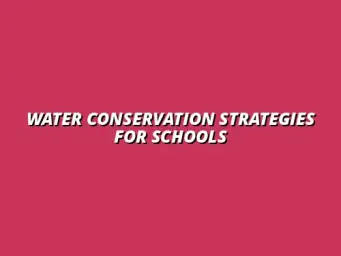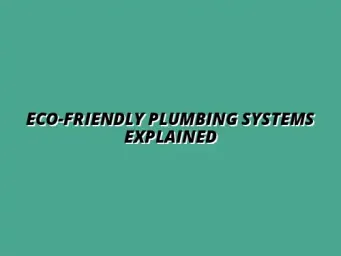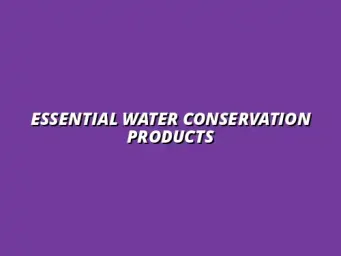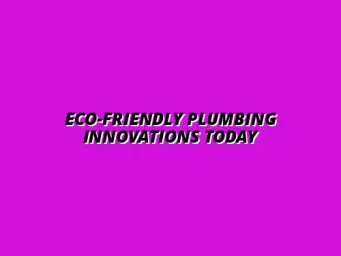The Evolution of Eco Plumbing and Water Conservation Technology
Eco plumbing has revolutionized the way we view water usage and conservation within our homes and communities. At its core, eco plumbing is about creating systems that not only provide clean water but also promote sustainable practices for the future. By understanding and implementing eco plumbing principles, we can make a significant impact on our environment while also enjoying the benefits of reduced water bills!
Furthermore, eco plumbing prioritizes resource conservation. It encourages the use of materials and techniques that minimize waste and protect our natural resources. As we delve into its principles and practices, it's essential to grasp the importance of eco plumbing in addressing the pressing water crisis the world faces today. For practical tips on conserving water in your bathroom, check out these water-saving bathroom plumbing tips.
Understanding Eco Plumbing: Principles and Practices
Defining Eco Plumbing and Its Importance
Eco plumbing refers to plumbing systems designed with sustainability and efficiency in mind. This approach emphasizes the reduction of water consumption through innovative technologies and practices. Its importance cannot be overstated, as it aims to curb water wastage while ensuring a steady supply for future generations. Learn more about the latest eco-friendly plumbing innovations transforming the industry.
By adopting eco plumbing practices, we can help tackle issues related to water scarcity and environmental degradation. Moreover, eco plumbing promotes awareness of our water usage habits and encourages a shift towards more sustainable choices at home.
The Role of Sustainable Practices in Plumbing
Sustainable practices in plumbing are vital for promoting environmental health. These practices include using recycled materials, employing water-saving fixtures, and integrating rainwater harvesting systems. For example, upgrading to low-flow faucets and showerheads can make a big difference. When plumbers and homeowners embrace these methods, they contribute to a more sustainable future.
- Utilizing low-flow faucets and showerheads
- Installing dual-flush toilets
- Implementing greywater recycling
Each of these practices plays a key role in minimizing water waste and enhancing system efficiency. Sustainable plumbing is not just about reducing water usage; it also reflects a commitment to the health of our planet. Discover simple yet effective water-saving tips for your home to start conserving today.
Historical Context: How Plumbing has Adapted Over Time
Plumbing has come a long way since its inception, evolving significantly as our understanding of water conservation has improved. In ancient civilizations, plumbing systems were primarily focused on providing clean water and managing waste. However, as awareness of environmental issues grew, there was a shift towards incorporating eco-friendly innovations.
Today, modern plumbing systems aim to balance functionality with sustainability, ensuring that water is used wisely and efficiently. This evolution reflects our growing recognition of the need for sustainable practices in all areas of life.
Traditional Plumbing vs. Eco-Friendly Innovations
Traditional plumbing systems often relied on high water usage, leading to unnecessary waste. On the other hand, eco-friendly innovations prioritize water efficiency and sustainability. These innovations include advanced technologies like smart water meters and water-efficient fixtures that help reduce consumption without compromising performance. Regular water heater maintenance is also crucial for efficiency.
- Traditional plumbing: High water flow rates
- Eco-friendly innovations: Low-flow technologies
- Traditional plumbing: Basic sewage systems
- Eco-friendly innovations: Greywater recycling
By embracing these eco-friendly innovations, we can make significant strides in conserving water and protecting our environment.
Key Milestones in Water Conservation Technology
The journey towards effective water conservation technology has seen numerous milestones. Each advancement has contributed to our current understanding and implementation of eco plumbing practices. Here are some key milestones:
- Introduction of low-flow toilets in the 1990s
- Development of smart water management systems in the 2000s
- Rise of rainwater harvesting techniques in urban areas
These milestones showcase the ongoing innovation in plumbing technology aimed at promoting water conservation. By learning from these developments, we can continue to enhance our plumbing systems for a sustainable future. Understanding greywater systems and water conservation is a key aspect of this.
The Future Trends Shaping Eco Plumbing and Water Conservation
The future of eco plumbing looks promising, especially with the advent of emerging technologies that focus on water conservation. These innovations not only aim to reduce water usage but also enhance the overall efficiency of plumbing systems. As we embrace more eco-friendly solutions, understanding these trends becomes crucial for homeowners and businesses alike. For those in Alcester, Birmingham, finding a reliable plumber specializing in eco-friendly solutions is a great first step.
One exciting area is the development of greywater recycling systems. These systems treat and repurpose wastewater from sinks, showers, and washing machines for non-potable uses, such as irrigation and toilet flushing. This not only conserves fresh water but also reduces the burden on sewage treatment facilities.
Emerging Technologies in Water Conservation
Innovations in Greywater Recycling Systems
Greywater recycling is gaining traction due to its numerous benefits. These systems can significantly cut down on water bills and decrease the amount of water that enters the sewage system. Moreover, they promote sustainability by providing a reliable source of water for landscaping and other non-drinking applications.
- Reduces overall water consumption
- Decreases wastewater treatment costs
- Provides an alternative water source for gardens
The Potential of Rainwater Harvesting Technologies
Rainwater harvesting is another innovative solution that is becoming more popular. By collecting rainwater from rooftops and storing it for later use, homeowners can significantly reduce their reliance on municipal water supplies. This practice not only saves money but also helps manage stormwater runoff, reducing the risk of flooding.
Some benefits of rainwater harvesting include:
- Lower water bills
- Reduced demand on local water supplies
- Enhanced landscape irrigation
The Integration of Renewable Energy Sources
Solar-Powered Water Heating Solutions
With the world leaning towards renewable energy, integrating solar power into plumbing systems is a game-changer. Solar-powered water heating systems can drastically cut energy costs while minimizing the carbon footprint. These systems capture sunlight to heat water, providing an efficient and sustainable alternative to traditional heating methods. Regular maintenance, including checking for leaks, is essential for optimal efficiency in your kitchen as well. Consider these essential kitchen plumbing maintenance tips.
Benefits include:
- Lower greenhouse gas emissions
- Reduced reliance on fossil fuels
- Long-term savings on energy bills
Combining Eco Plumbing with Sustainable Energy Practices
The future of eco plumbing also involves a harmonious blend of plumbing and sustainable energy practices. By designing systems that utilize renewable energy sources alongside water-saving fixtures, we can create a closed-loop system that greatly enhances efficiency. This integration sets a strong foundation for a more sustainable and resilient infrastructure.
In conclusion, these developments showcase the potential for eco plumbing to significantly improve our water management and conservation practices. By embracing new technologies and strategies, we can contribute to a healthier planet for future generations.
Exploring Consumer Engagement and Education Strategies
Consumer engagement is essential in promoting eco plumbing and water conservation efforts. Educating the public about sustainable practices can lead to better adoption of water-saving technologies. By raising awareness, we can inspire individuals and communities to make informed choices that benefit both the environment and their wallets.
Community initiatives play a vital role in this engagement. Programs that encourage local participation in water conservation projects can be effective in fostering a culture of sustainability. People are often more motivated when they see direct benefits and collaborative efforts in their neighborhoods.
Raising Awareness on Water Conservation Practices
Community Initiatives and Their Impact
Community initiatives can have a lasting impact on water conservation. These programs may include workshops, clean-up events, and challenges that encourage residents to adopt eco-friendly plumbing practices. By getting involved, communities can collectively reduce their water usage and promote a more sustainable lifestyle.
- Neighborhood clean-up days focused on local water bodies
- Workshops on installing water-saving fixtures
- Challenges to reduce water consumption at home
Leveraging Social Media and Technology for Education
Social media is a powerful tool for spreading awareness about water conservation. Platforms like Facebook, Instagram, and Twitter can be used to share tips, videos, and success stories related to eco plumbing. By utilizing these channels, we can reach a wider audience and encourage more people to adopt sustainable practices.
Examples of engaging content may include:
- How-to videos for installing low-flow fixtures
- Infographics on the benefits of rainwater harvesting
- Success stories from community members
The Future of Eco Plumbing in Urban Development
Incorporating Eco Plumbing in Smart Cities
As cities become smarter, incorporating eco plumbing solutions is critical. Smart cities focus on sustainable infrastructure that includes efficient water management systems. Utilizing technology, these cities can provide better services while conserving valuable resources.
Features of eco plumbing in smart cities may include:
- Real-time water usage monitoring
- Automated leak detection systems
- Integration of green spaces with natural water recycling
Collaborations Between Plumbers, Builders, and Designers
Future eco plumbing projects will likely involve collaborations among various stakeholders. By working together, plumbers, builders, and designers can create innovative solutions that prioritize sustainability. This teamwork will be essential in shaping the direction of eco plumbing and ensuring that it meets the needs of modern society.
Through these collaborations, we can envision a future where eco plumbing is not just an option, but the standard for all building projects.
Final Thoughts on Eco Plumbing and Water Conservation Technology
In closing, the importance of sustainable plumbing solutions cannot be understated. As we face increasing challenges related to water scarcity and environmental degradation, embracing eco plumbing practices is essential. The innovations and trends discussed highlight the necessity for proactive measures that promote water conservation.
It's vital for individuals and communities to take responsibility for their water usage. Every small action, from installing low-flow fixtures to participating in local conservation programs, contributes to a larger impact. Together, we can create a future that values sustainability and prioritizes the well-being of our planet.
Encouraging Action Towards Eco-Friendly Plumbing Choices
How Readers Can Get Involved in Sustainable Practices
Readers can play an active role in promoting eco plumbing by making informed choices. This could involve upgrading fixtures to more efficient models, participating in local awareness campaigns, or advocating for better water policies in their communities. Every action counts and is vital for fostering a culture of sustainability.
Resources for Further Learning and Engagement
To continue learning about eco plumbing and water conservation, various resources are available. Websites, local libraries, and community centers often offer information on sustainable practices and technologies. By tapping into these resources, you can stay informed and engaged in the movement towards a more sustainable future.
In conclusion, the journey towards eco plumbing and water conservation is ongoing. By embracing innovation and encouraging community involvement, we can make a lasting difference!









